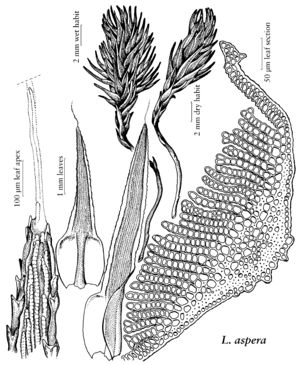Lyellia
Trans. Linn. Soc. London 12: 561. 1819 ,.
| Taxon | Illustrator ⠉ | |
|---|---|---|
 | Lyellia aspera | Patricia M. Eckel |
Plants robust, polytrichoid. Stems simple or rarely branched. Leaves with a sheathing base and divergent blade; sheath entire, hyaline-margined; limb firm, serrate-toothed in distal 1/3–1/2, with lamellae restricted to median portion of the limb, the lamina ± uniformly 2-stratose; lamellae entire, the marginal cells in section not differentiated, smooth. [Capsule ovoid, strongly dorsiventral, the upper surface flattened and concave with a narrow winged margin, lower surface rounded-convex, with hypophysis short, with conspicious stomata, guard cells surrounded by a circle of thin-walled, hyaline cells; operculum compressed-conic, with elongated oblique beak; peristome none; columella apex flattened and protruding from the central opening of a concave, thickened disc. Calyptra sparsely hairy to almost smooth. Spores echinulate.]
Distribution
North America, e Asia (including Siberia)
Discussion
Species 4 (1 in the flora).
Lyellia is a small genus with a disjunctive distribution, with representatives occurring in the Himalayas and eastward, and a single species, L. aspera, at high latitudes in arctic America and eastern Asia. The capsules are strongly dorsiventral, resembling those of Dawsonia in shape, but without a peristome. The flattened columella apex projects from the center of the disc like a stopper in a wash basin (Gary L. Smith 1971, fig. 25); the epiphragm remains embedded in the operculum. The hypophysis has prominent stomata, the guard cells surrounded by a ring of thin-walled, hyaline subsidiary cells, which are sharply differentiated from the surrounding cells of the exothecium.
Selected References
None.
Lower Taxa
"broadened" is not a number.